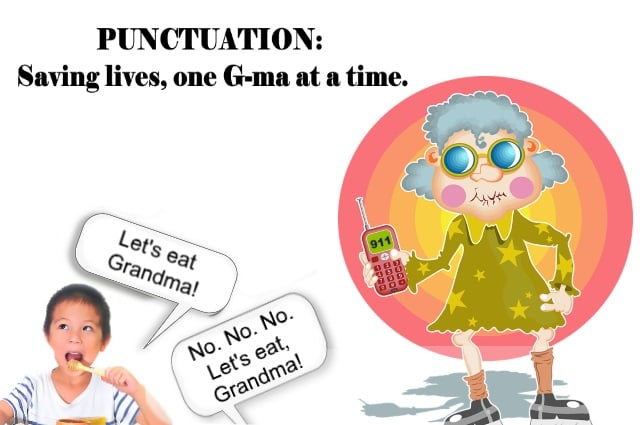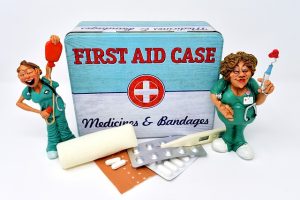If you’re used to texting, you might not think that things like spelling, capitalization, or punctuation even matter, but …
just imagine ur reading an entire news article textbook or even a blog post with no capitalization and no punctuation it would be really hard to tell where one thought ended and it would be more than a little annoying right
Now think about how annoyed your professor would be if he had to read an essay filled with all sorts of grammar and punctuation errors like those in the paragraph above. I’m guessing he’d start marking up your paper in a rage (because you know he has a brand new red pen, and he’s not afraid to use it). Ultimately, he’d probably just give up and write in big, bold red letters: “SEE ME!”
When you read a comment like that, you know it’s serious, and you’re probably thinking, “This is gonna kill my grade.” Worse yet, you’re likely in a panic because deep down you’re also thinking, “My parents are gonna kill me if I fail this class.”
Punctuation is serious stuff, so if you want to save your grade (and possibly your life), keep reading to learn how to avoid these five punctuation errors.
5 Punctuation Rules You Need to Know
I’m guessing there are about a million rules for punctuation (give or take a few), so there’s no possible way I can cover all of them here. Instead, I’m going to focus on five punctuation rules that often confuse people.
FYI: A few of these are also professor pet peeves, so it’s a good idea to master them in order to avoid seeing red the next time you get your paper back.
Rule #1: Use a colon to introduce a list of items
Like with most punctuation marks, there are several different ways to correctly use a colon, but in order to follow this specific rule, you need to do two things:
- Include a complete sentence before the colon.
- Include a list of related items following the colon.
Example:
When I hike, I always carry the following three items in my backpack: sunscreen, water, and snacks.
This example uses the phrase “the following three items” to correctly introduce the list. (If you’d like to see another example, take a look at the sentence just before the example. It uses a colon to introduce the rules for using a colon.)
Use a colon only if you’re creating a list as in the examples above. If you incorporate the list of items into the actual sentence, you would not use a colon.
Example:
When I hike, I always carry sunscreen, water, and snacks in my backpack.
Rule #2: Use a semicolon to separate two related complete sentences
A semicolon is a period stacked on top of a comma. It creates a pause a little longer than a comma but not quite as long as a period. (Perhaps that’s why it’s both a comma and a period combined?)
One of the more common sentence-level errors (that is definitely a professor pet peeve) is incorrectly using a semicolon to join ideas.
Here’s an example of an incorrect use of a semicolon:
We hiked several trails yesterday; and were gone for over four hours.
Though the idea before the semicolon is a complete sentence, the information that follows the semicolon is not. It’s a sentence fragment because it’s missing a subject.
Here’s an example of the correct use of a semicolon:
We hiked several trails yesterday; we were gone for over four hours.
The example above correctly uses a semicolon because the ideas both before and after the semicolon are complete sentences.
Once you’ve mastered the rule of joining two complete sentences with a semicolon, move on to the next part of the rule: the fact that the two sentences must be related.
In other words, don’t write something like this:
We hiked several trails yesterday; next year we plan to vacation in Alaska.
While these sentences might be related because you went hiking on your vacation and you’re talking about vacation plans next year, they aren’t close enough in content to use a semicolon.
Rule #3: Never make words plural by adding an apostrophe
Remember when I said earlier that punctuation is serious stuff? I mean it! Punctuation can change your life forever. As evidence, I present the sign below.

This sign incorrectly uses an apostrophe to make the word “tattoo” plural.
Never, ever use an apostrophe to make a word plural. Never.
Let’s think about this for a minute. It seems that the owners of this tattoo shop don’t know how to properly use punctuation.
That means if you get a tattoo with any wording on it, you could very well end up with a misspelled word or improper punctuation, making you the butt of jokes (or the subject of bad tattoo photo galleries) and changing your life forever. (See how important proper punctuation is?)
So remember: don’t use apostrophes to make words plural.
When exactly do you use an apostrophe?
Apostrophes are generally used to show possession, such as, “Ian’s tattoo was a masterful piece of artwork.” They’re also used to create contractions, such as “don’t” to replace “do not” or “shouldn’t” to replace “should not.”
Rule #4: Never join two complete sentences with a comma
Incorrectly joining two complete sentences with a comma results in a comma splice, and it’s certainly a major pet peeve of a lot of profs.
Incorrect use of comma to join sentences (comma splice):
I’m going to get a tattoo tomorrow, I hope I like the finished design.
Though these two sentences are related, you can’t simply add a comma to join them. Instead, you’ll need to connect them using one of four acceptable strategies.
Here are four basic strategies (with examples) you can use to correct a comma splice.
- Join two sentences with semicolon (see Rule #2 above):
I’m going to get a tattoo tomorrow; I hope I like the finished design.
- Join two sentences with a period:
I’m going to get a tattoo tomorrow. I hope I like the finished design.
- Make one of the sentences a subordinate clause:
When I get my tattoo tomorrow, I hope I like the finished design.
- Join two sentences by adding a comma and a coordinating conjunction:
I’m going to get a tattoo tomorrow, so I hope I like the finished design.
Rule #5: Set off a direct address with a comma
Whenever you directly address someone, you need to note it through use of a comma.
Here’s an example:
“Excuse me, sir, do you know the time?”
This rule may sound simple enough, but it’s another one of those potentially life-saving punctuation rules.
What? You still don’t believe punctuation has that much power? Check out these two sentences.
Example sentence #1:
“Let’s eat, Grandma!”
Here, a family member is happily asking Grandma to join them for dinner. This sentence correctly uses a comma when directly addressing Grandma.
Example sentence #2:
“Let’s eat Grandma!”
Here, a family member is so hungry that he’s suggesting they actually eat Grandma for dinner.
The missing comma in the direct address changes the entire meaning of the sentence.
But don’t think this is an isolated instance of punctuation saving lives. Imagine walking on a path and seeing a sign that reads:
Hunters Use Caution When Shooting
Walkers on Path
Yikes! I’m sure that hunters aren’t really hunting pedestrians, but without proper punctuation, that’s certainly what the sign is suggesting.
(For the record, there should be a comma after “hunters”—because of that direct address rule above—plus periods after “shooting” and “path.”)
See? Punctuation saves lives! It can save your grade too, so make sure to follow the rules.
A Little Writing First Aid
Now that you’ve mastered these five punctuation rules, you may be questioning whether you’ve been following other important punctuation and grammar rules.
While it’s okay to sometimes ignore other writing rules, punctuation isn’t one of those times. If you’d like to brush up on a few more basics, read these articles:
- Avoid These 10 Common Grammar Mistakes in Your Paper
- 7 Grammar Rules That Everyone Should Learn
- Dangling Modifier: Don’t Make This Funny Grammar Mistake
Want to see punctuation in action? Check out these example problem/solution essays in our database. Test yourself to see if you spot any of the rules being used correctly (or incorrectly) in the example essays.
Still struggling with punctuation rules and feel that your paper is on life support? Rush your draft to the Kibin editing team for a little writing first aid.
They’ll not only catch your punctuation errors, but they can help with grammar, spelling, word choice, clarity, and more.



